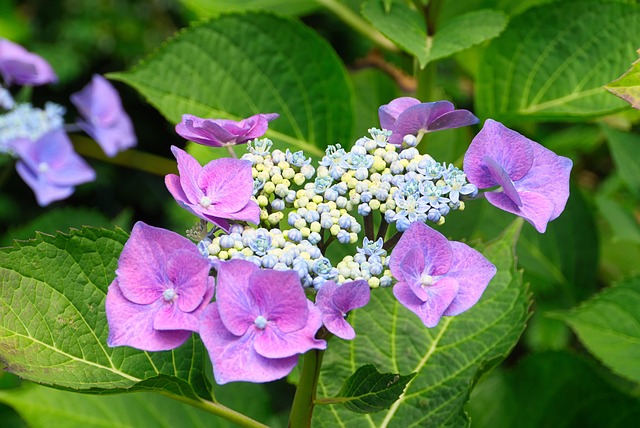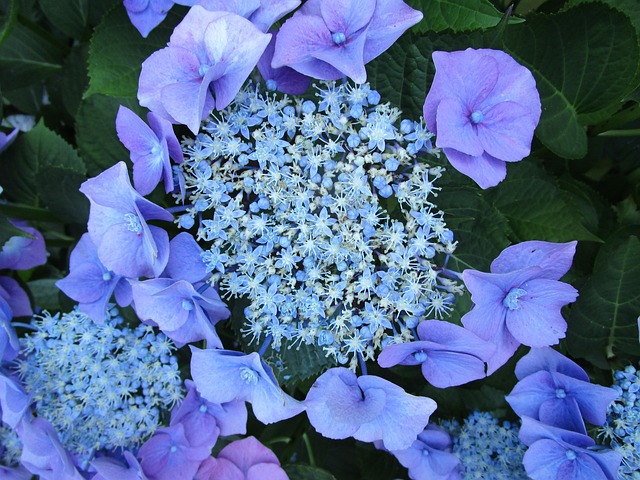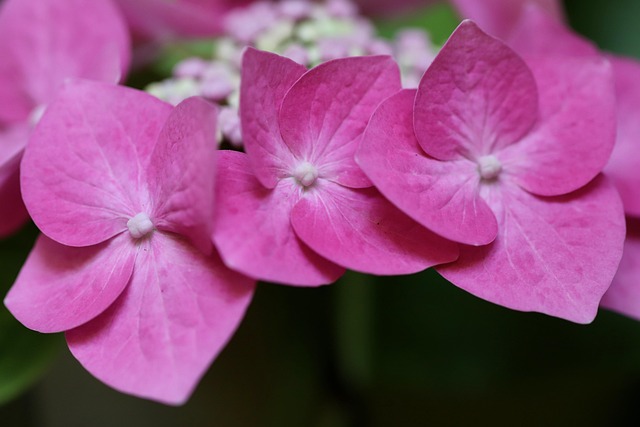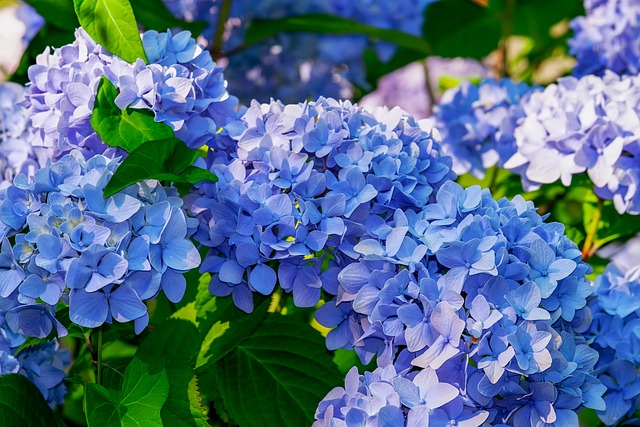Japan is renowned for its spectacular seasonal flowers, and among these, the hydrangea (known as “ajisai” in Japanese) holds a special place in the country’s heart and culture. These beautiful blooming shrubs transform the landscape during the rainy season, creating a magical atmosphere with their vibrant colors ranging from deep blues to purples, pinks, and whites. With over 100 varieties of hydrangeas found throughout Japan today, these flowers have become an essential part of the Japanese seasonal experience.
Hydrangeas in Japan aren’t just ordinary garden plants; they represent the transition from spring to summer and bring color to the otherwise dreary rainy season. This article explores the rich diversity of Japanese hydrangea varieties, their cultural significance, and the best places to experience their beauty.
History and Cultural Significance

The relationship between Japan and hydrangeas dates back more than a millennium. Native hydrangea species have been mentioned in Japanese written records from the 8th century, specifically in the Man’yoshu, Japan’s oldest collection of waka poems from the Nara period (710-794). These early references indicate how deeply rooted these flowers are in Japanese culture.
While native varieties have always been appreciated, European hydrangea varieties were introduced to Japan in the early 20th century, adding to the diversity and popularity of these flowers. The cultural appreciation of hydrangeas in Japan is evident in various aspects of Japanese art, literature, and seasonal celebrations.
During the Edo period (1603-1868), samurai particularly honored the hydrangea for its ability to change color depending on its environment. This trait was seen as a symbol of adaptability and uniqueness—qualities highly valued by these warriors. The flowers were also associated with immortality due to their long-lasting blooms.
Native Japanese Hydrangea Varieties
The most distinctive native Japanese hydrangea is the Gaku Ajisai (mountain hydrangea), scientifically known as Hydrangea serrata. This species is considered the ancestral form of many contemporary hydrangea varieties.
Characteristics of Gaku Ajisai
Gaku Ajisai has a unique appearance that distinguishes it from modern cultivars:
- Small, fertile flowers clustered at the center
- Surrounded by larger sterile flowers that resemble a picture frame (hence the name “gaku,” which means “frame” in Japanese)
- More delicate and smaller flower clusters compared to Western varieties
- Heights typically ranging from 30 cm to 2 meters
- Natural habitat in mountain forests throughout Japan
One particularly special native variety is the “Shichidanka”, once a legendary mountain hydrangea characterized by its double-layered blossoms that resemble stars. These can still be seen in specialized gardens like the Rokko Alpine Botanical Garden in Kobe.
Another notable native variety is the “Yamaajisai” (Hydrangea macrophylla serrata), which grows in the mountainous regions of central Honshu. This variety is used to make a special herbal tea called “Amacha” (sweet tea), which is used in Buddhist ceremonies.
Modern Cultivars in Japan

Through selective breeding of the native Gaku Ajisai, many modern cultivars have been developed both in Japan and abroad. These are the hydrangeas most people recognize today, with their large, showy blooms.
Popular Modern Varieties in Japan
| Variety | Type | Color Range | Special Features |
|---|---|---|---|
| Honajisai | Mophead | Blue, pink, purple | Large, ball-shaped clusters up to 30 cm |
| Annabelle | Smooth | White, lime-green | Massive snowball-like blooms |
| Rokko Blue | Lacecap | Vivid blue | Distinctive color found at Mt. Rokko |
| Kurenai | Lacecap | Deep red | Flowers start white, turn red with sun exposure |
The Hydrangea macrophylla mophead, called “Honajisai” in Japanese, is the most common cultivated variety. It features:
- Oval inflorescences up to 30 cm large
- Sterile flosculi (flowers that cannot be pollinated)
- Large decorative petaloid sepals
- Elliptical and pointed leaves with toothed margins
- Heights between 1.5 and 2 meters
Modern Japanese gardeners have developed numerous cultivars that thrive in Japan’s climate and showcase a stunning variety of colors and forms.
Why Hydrangeas Change Colors
One of the most fascinating aspects of hydrangeas is their ability to change color based on soil conditions. This characteristic has made them particularly beloved in Japan, where they symbolize transformation and adaptability.
The color-changing phenomenon is primarily seen in blue and pink varieties and is due to a scientific process:
- In acidic soil (pH below 6), aluminum becomes more soluble and is absorbed by the plant, producing blue flowers
- In alkaline soil (pH above 6.5), aluminum is less available, resulting in pink flowers
- In neutral soil (pH 6 to 6.5), flowers may appear purple or a mixture of blue and pink
This is why the same hydrangea plant might display different colored flowers after being transplanted to a new location with different soil chemistry. Japanese gardeners often add specific soil amendments to achieve their desired colors:
- Aluminum sulfate to enhance blue colors
- Garden lime to encourage pink hues
Additionally, hydrangeas naturally change color as they age, typically starting as greenish-white before developing into their mature coloration and eventually fading to a different shade at the end of the season.
Flower Language and Symbolism
In Japanese flower language (hanakotoba), hydrangeas carry several meanings that reflect both their beauty and their changing nature.
Meanings by Color
- Blue hydrangeas: Symbolize “patient love,” “coldness,” “impermanence,” and “mystery”
- Pink hydrangeas: Represent “strong affection” and “energetic woman” (popular as Mother’s Day gifts)
- White hydrangeas: Associated with “tolerance” and “purity”
- Purple hydrangeas: Represent “desire to deeply understand someone”
The general symbolism of hydrangeas in Japan includes:
- Family togetherness
- Perseverance
- Fickleness (due to their changing colors)
- Gratitude
A popular Japanese legend says that finding a snail on a hydrangea is a sign of good fortune, adding another layer of cultural significance to these beloved flowers.
Growing and Caring for Hydrangeas in Japan

Japanese gardeners have perfected the art of growing beautiful hydrangeas adapted to the country’s climate. Here are some key aspects of hydrangea care in Japan:
Optimal Growing Conditions
- Light: Most Japanese hydrangeas prefer partial shade, especially during hot afternoon hours. The Japanese native varieties can tolerate deeper shade than Western cultivars.
- Soil: Rich, well-draining soil with good moisture retention is ideal. Many Japanese gardens amend soil with organic matter like composted leaves.
- Water: Regular watering is essential, especially during dry periods. Hydrangeas in Japan benefit from the natural moisture of the rainy season but need supplemental water during dry spells.
- Pruning: Different varieties require different pruning approaches:
- Mophead types: Prune after flowering but before August
- Mountain hydrangeas: Require minimal pruning, just removal of dead wood
- Winter Protection: In colder regions of Japan, such as Hokkaido, hydrangeas may need protection from freezing temperatures.
Japanese gardeners often follow the traditional practice of cutting flowers prematurely to ensure good flowering in the following year, focusing on long-term garden beauty rather than maximizing a single season’s display.
Famous Hydrangea Viewing Spots
Japan offers numerous spectacular locations to view hydrangeas during their blooming season. Here are some of the most renowned spots across the country:
Tokyo and Surrounding Areas
- Hakusan Shrine (Tokyo): Home to the annual Bunkyo Hydrangea Festival in mid-June, featuring over 3,000 hydrangea plants. Official Site
- Takahata Fudoson Temple (Tokyo): Known as the “Hydrangea Temple,” it boasts about 7,500 hydrangea plants of 200 different varieties. Official Site
Kamakura and Hakone
- Meigetsu-in Temple (Kamakura): Famous for its blue hydrangeas and known as the “Hydrangea Temple.” Official Site
- Hakone Tozan Railway (Hakone): Ride this mountain railway through a corridor of hydrangeas so close you can almost touch them from the train windows. Official Site
Other Notable Locations
- Mimurotoji Temple (Kyoto): Called the “Flower Temple,” it features a garden with various seasonal flowers, including spectacular hydrangeas. Official Site
- Hattori Hydrangea House (Chiba): A sprawling 18,000 square meter property with around 250 varieties and over 10,000 hydrangea plants. Official Site
- Rokko Alpine Botanical Garden (Kobe): Famous for its vivid “Rokko Blue” hydrangea variety and the rare “Shichidanka” mountain hydrangea. Official Site
Many visitors share their experiences at these locations on social media. For instance, one visitor to Meigetsu-in posted on Instagram: “The blue hydrangeas against the ancient temple walls created a scene straight out of a dream. Definitely worth braving the rain for this view! #AjisaiJapan”
Blooming Season and Best Time to View
Hydrangeas in Japan typically bloom during the rainy season, making them a perfect complement to this otherwise gloomy weather period.
Blooming Timeline by Region
- Okinawa and Southern Islands: Early May to late June
- Kyushu and Shikoku: Late May to early July
- Honshu (Main Island): Early June to mid-July
- Hokkaido: Late June to late July
The peak viewing period usually falls between mid-June and early July for most of Japan, though this can vary depending on the year’s weather conditions and the specific variety.
Different varieties also have slightly different blooming periods:
- Early-blooming varieties start in late May
- Mid-season varieties peak in June
- Late-blooming varieties continue into July
Hydrangea flowers are quite long-lasting and usually look beautiful for three to four weeks before the flowering officially ends, giving visitors a relatively long window to enjoy them compared to the famously brief cherry blossom season.
Many gardens and temples extend their viewing hours during the peak season, with some offering evening illuminations that create a magical atmosphere as the flowers glow against the darkness.
Conclusion
Japanese hydrangeas, from the native Gaku Ajisai to the numerous modern cultivars, represent a beautiful fusion of natural beauty and cultural heritage. These versatile flowers have been cherished in Japan for over a millennium, evolving from woodland natives to carefully bred garden favorites.
Whether you’re admiring the frame-like blossoms of mountain hydrangeas, the massive blooms of modern mophead varieties, or the legendary Rokko Blue with its striking color, Japanese hydrangeas offer an incredible diversity of forms and hues that brighten the rainy season landscape.
The next time you visit Japan between May and July, consider making time to experience these magnificent flowers. From temple gardens to mountain railways, hydrangeas transform Japan’s landscape during the rainy season, proving that even cloudy days can be filled with extraordinary beauty.
Understanding the rich history, cultural significance, and sheer variety of Japanese hydrangeas adds another layer of appreciation to these remarkable flowers that have become synonymous with early summer in Japan.


